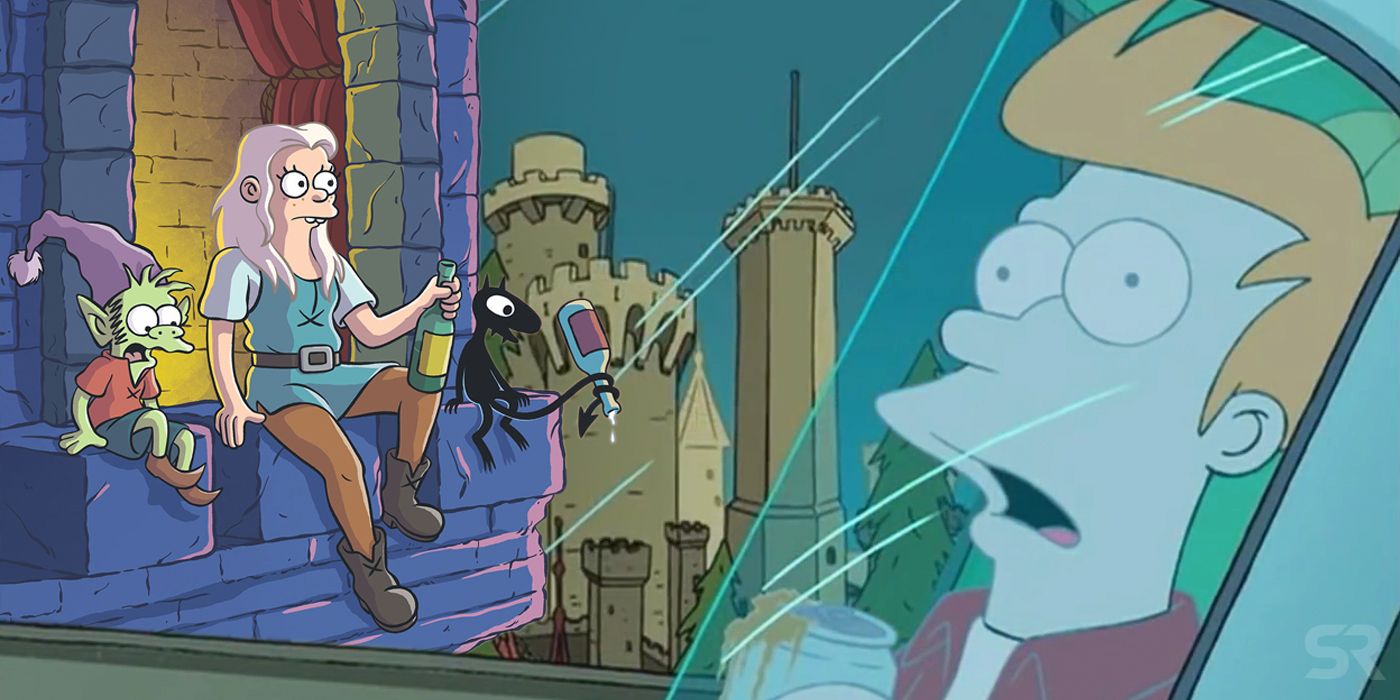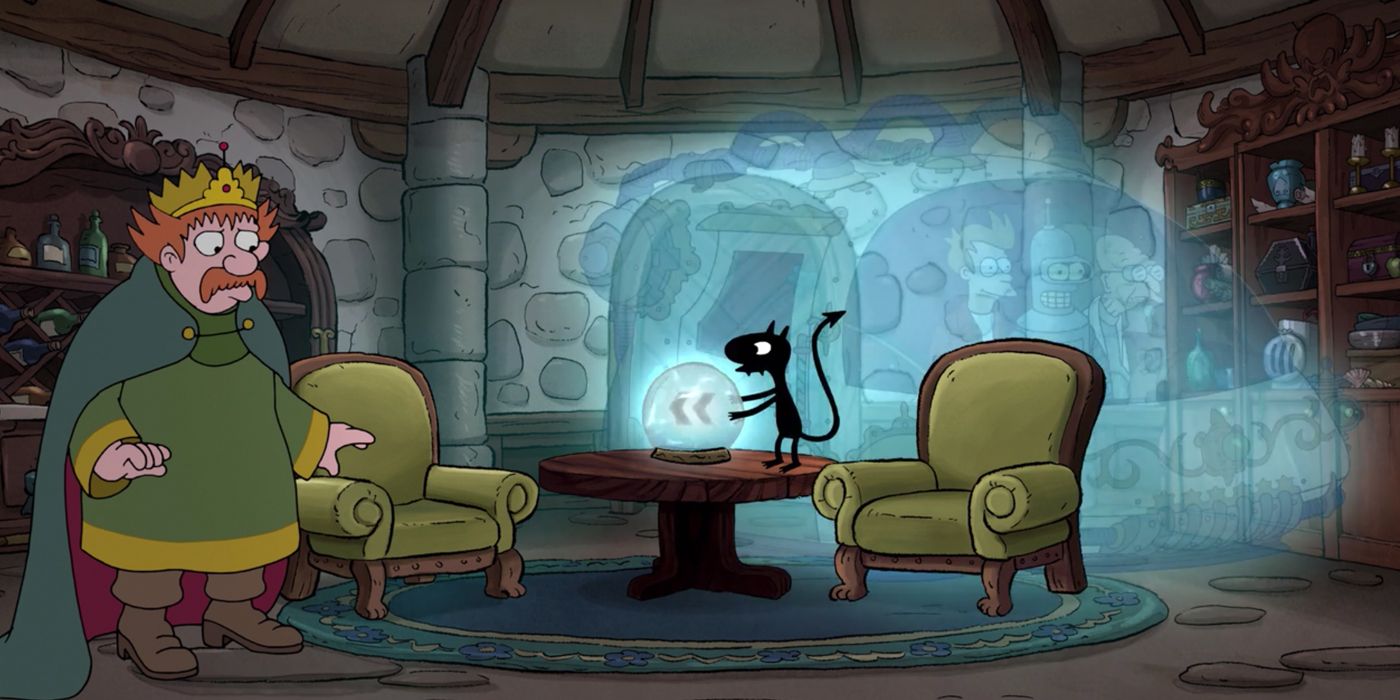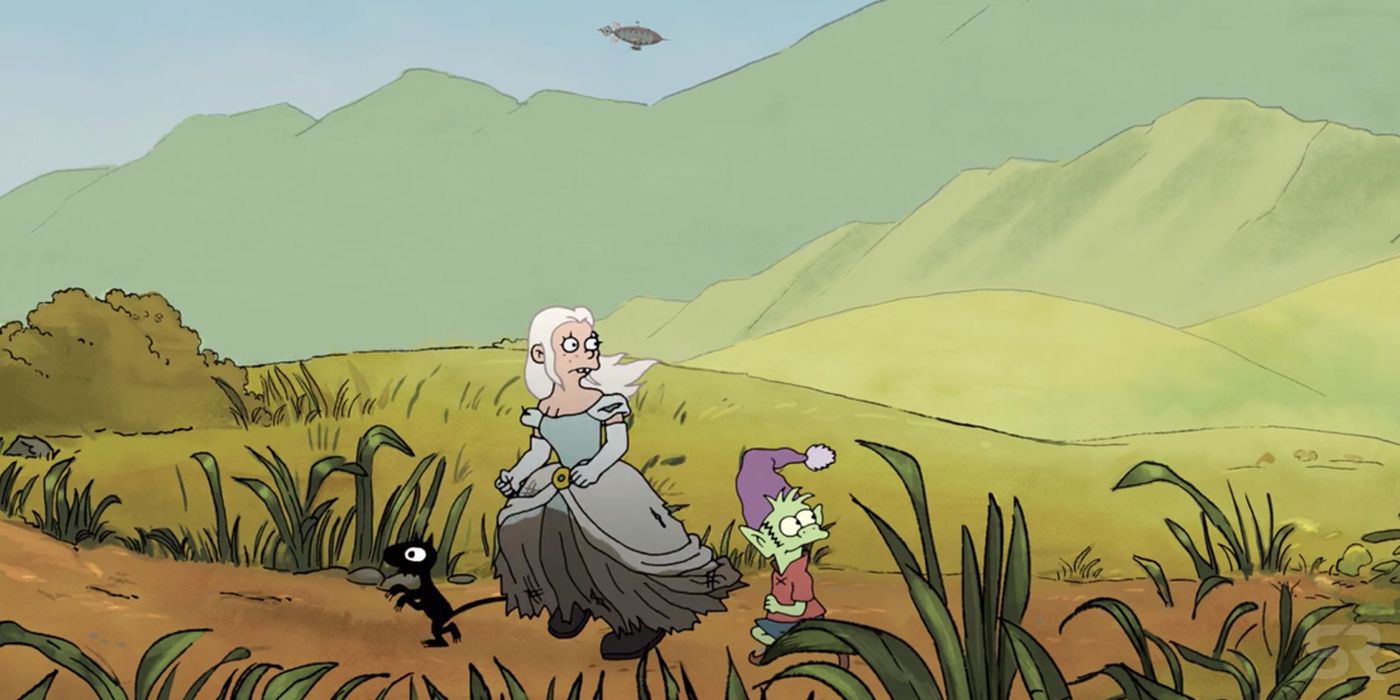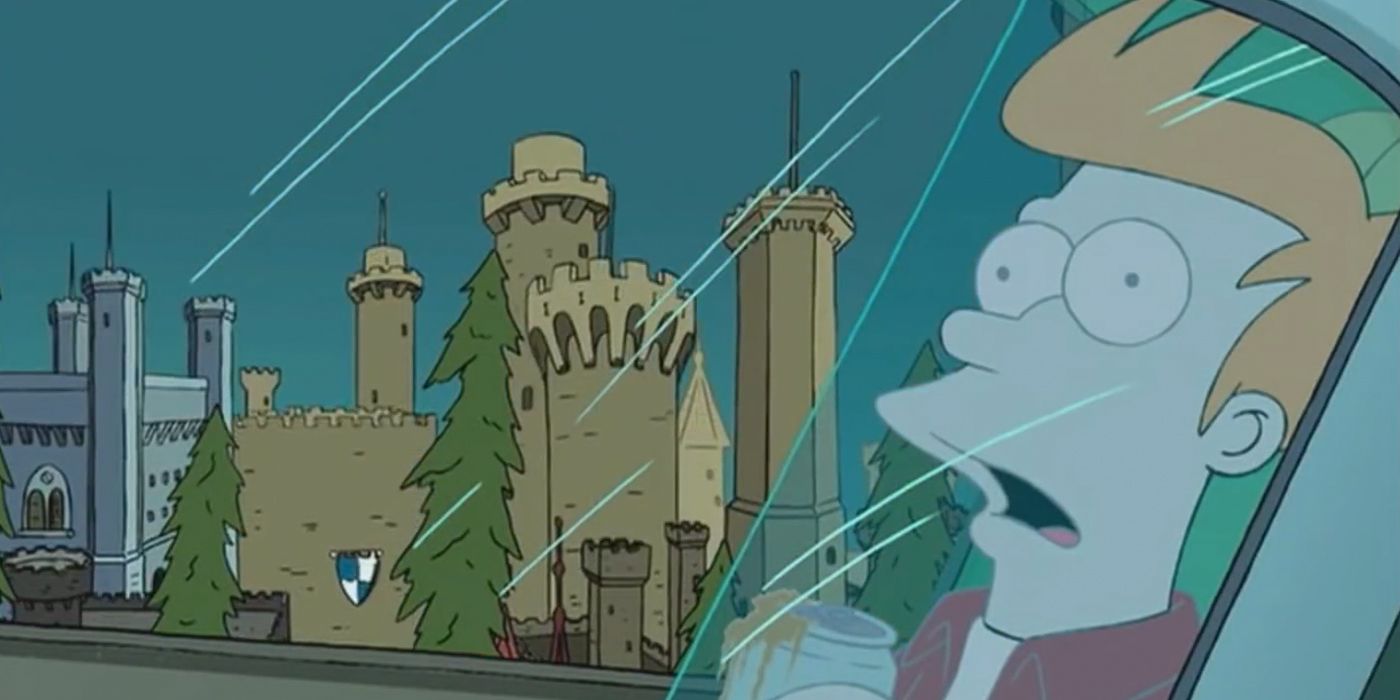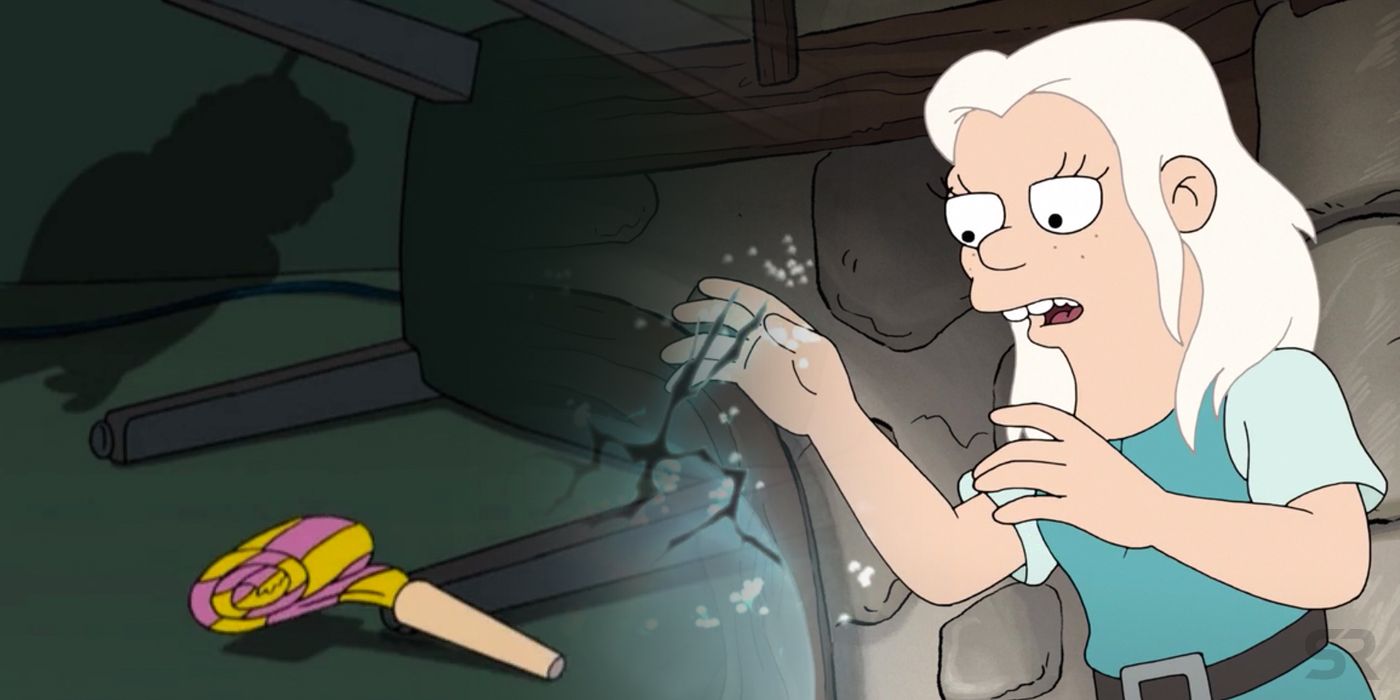Disenchantment is a medieval fantasy show... or is it? Gradually, evidence is emerging about Matt Groening's Netflix animation that suggests it may be closer to Futurama's world and setting than it first seems.
Ostensibly doing for the fantasy genre what Futurama did for sci-fi, Disenchantment riffs on a bunch of nerd favorites to tell a decidedly new story. It follows Princess Bean, her demon Luci and friend/love interest Elfo on a series of alcohol-fuelled misadventures. As the series went on, however, a bigger narrative emerged: Bean is at the center of a centuries-long battle between the forces of good and evil, influenced by far-off sorcerers and her presumed dead mother.
Related: What To Expect From Disenchantment Season 2
Disenchantment season 1 ended with a cliffhanger for every major character: Bean was taken away to confront her destiny, Luci was captured, the population of Dreamland was petrified, and in a post-credits scene Elfo's corpse was taken by mermaids. But none of the resulting questions about Elfo's parentage or Dankmire's real goals are what we should have been asking. Fans should have taken this opportunity to zoom out of the crudely drawn map and ask: just when and where is Disenchantment set anyway?
- This Page: Disenchantment Isn't Set When You Think It Is
- Page 2: Is Disenchantment Futurama's Medieval 2300s Society?
Disenchantment Is In The Futurama Universe
The world of Dreamland was gradually expanded across the first season of Disenchantment, with other cultures and a deeper mythology teased ahead of season 2. However, the most important piece of world-building is a blink-and-you'll-miss-it Easter egg that places the series in the same universe as Futurama.
In the season finale, Luci shows King Zog some magic holograms of past events using the omni-purpose crystal ball. In one of these quick flashes is Fry, Bender and the Professor in the time machine from Futurama's season 6 episode "The Late Philip J. Fry". The story of that episode saw the trio travel forward through time billions of years into the future, past the end of the universe and through the creation of another, identical universe (and then again, because they slightly overshoot the first time). It's one of Futurama's classic meldings of high concept sci-fi and emotional character storytelling, but could prove to be even more important than that.
The appearance of the time machine in a Disenchantment hologram would seem to confirm that the Netflix show takes place in the same continuity as Futurama. There's room for debate on which iteration of the universe it was, although given they're for all intents and purposes identical, that doesn't really matter. The obvious conclusion is that Disenchantment is in the past of Futurama, some time in the Dark Ages. But that may not be the case...
Related: Disenchantment's Futurama & Simpsons Easter Eggs
Disenchantment May Not Actually Be Set In The Past
Disenchantment is ostensibly a high fantasy that pulls from a variety of literary and mythical inspirations, with a wide range of magical creatures and locales, but is ultimately set in a world riffing on the Dark Ages. Except things don't quite fit.
In the very first episode, as Bean, Elfo and Luci run into the Enchanted Forest, for a brief moment a steampunk blimp can be seen in the background passing over a mountain. Although it's very small in the distance, it's most certainly out of line with the rest of the series. Throughout Disenchantment, the characters only ever fly with the help of a griffin; most long-distance travel being by period-accurate horse or ship. This hidden blimp, an easy to miss Easter egg, shows that there is some greater technology - importantly, this isn't really anything fantastical - at least a few centuries ahead of the assumed setting. Evidently, Disenchantment isn't set quite as far back as we expected.
Considering Matt Groening's propensity to hide clues to later twists in early episodes - Nibbler's shadow appears in Futurama's pilot, foreshadowing the season 4 reveal of his involvement in sending Fry to the future - this can't be discounted, and is surely a wink to one of Disenchantment's biggest secrets.
Page 2 of 2: Is Disenchantment Futurama's Medieval 2300s Society?
Is Disenchantment Futurama's 2300s Medieval World?
Ever since it was announced that Matt Groening's Netflix show was going to be set in a medieval society, one bonkers fan theory has been simmering in the background. In the Futurama pilot, after Fry is frozen we see the world change outside the Applied Cryogenics window: first New York City is leveled by flying saucers, then a castle-based society is built up before being destroyed again, eventually replaced by New New York. This history of NYC has been touched upon in the show, with movie Bender's Big Score revealing the first destruction was a result of a time-traveling Bender chased by the Swedish air force, but information on the second city has been light. All we know is that it likely existed in the 2300s; Bender destroyed Old New York in 2308 and the pilot episode substituted "Get 24th century on his ass" for "Get medieval on his ass".
Related: Disenchantment: All The Fantasy Easter Eggs & References
Could that second New York be linked to Disenchantment? The idea took hold before release, and nothing in the resulting show seemed to refute it. In Disenchantment, we don't actually see that much of the world. Dreamland is a single city, and its surrounding lands just a few days ride. There are both Maru and Cremorrah across the sea, but again the view is limited (and the latter is an overthrown desert). In terms of timeframe, we know of events 100 years in the past with Zog's 100-year war with Dankmire, and Bean's mother Dagmar alludes to a conflict hundreds of centuries long, although any firm details on what that means in the framework of the medieval society is hidden.
With Disenchantment in the Futurama universe and not necessarily set when it's alleged to, the time period where New York was covered by castles is a solid fit: it can be posited that, along with Bender's destruction of New York, the world entered a technological purgatory where fantasy creatures (more likely aliens) became assimilated into everyday life, while some cultures preserved the knowledge of flight (hence the blimp). This would line up with how the technology in Futurama's Year 3000 has a lot of 20th Century parallels - everything redeveloped from a similar past. At present, there's nothing much to refute it, although no hard evidence either.
Although that's part of the beauty of this idea; it needn't clash too much with the grand narrative Disenchantment is telling. The two shows can exist alongside each other, but the time period difference isolates them from becoming too intertwined (while still leaving to door open for a crossover eventually). The theory could even explain some of the big picture mythology, with the inevitable destruction of the castles by flying saucers (possibly Bender again) what Dagmar and her acolytes are plotting to avert.
Is There An Even Bigger Secret In Disenchantment?
Of course, it's one thing to drop a Futurama Easter egg. It's another to have it be a major plot point (this needn't be the xenomorph skull in Predator 2). This blimp is clearly going to be important, and it doesn't have to be a Futurama link; ignoring the Easter egg, what it unquestionably shows is that there is some corner of Disenchatnment's world where mechanical flight has been achieved, meaning that the Dark Ages needn't be quite so Dark.
As the Maru plot involving Luci seems linked to Cremorrah's destruction and the method of turning enemies to stone is shared by Dagmar, it's possible that it's all tied up into that, with Dreamland held back by its dogmatic, religious culture and a more enlightened society existing. This would be an apt commentary on the real Dark Ages, where the restrictions of Christianity imposed on Britain held back technological development in contrast to the height of the Roman Empire, and would make for a more varied aesthetic to the show going forward.
-
There's a lot of big surprises coming in Disenchantment's future, but the biggest is surely when it's set. We'll have to wait for season 2 to find out the truth.

